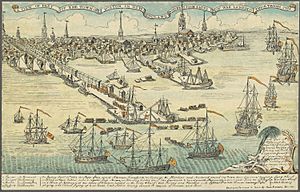Journal of Occurrences facts for kids
The Journal of Occurrences, also known as the Journal of the Times or Journal of Transactions in Boston, was a collection of newspaper articles published between 1768 and 1769. These articles appeared in the New York Journal and Packet and other newspapers. They told the story of what happened when the British Army took control of Boston.
No one officially signed their name to these articles. However, many people believe Samuel Adams wrote them. At that time, he was the clerk for the Massachusetts House of Representatives. Another person, William Cooper, who was Boston's town clerk, is also thought to be a possible author. It's also possible that a group of people worked together to write these important articles.
Contents
Why British Troops Came to Boston

The British Army came to Boston because of new laws called the Townshend Acts. The British Parliament passed these laws in 1767. Many colonists in America did not like these acts.
In February 1768, the Massachusetts House of Representatives wrote a letter called the Massachusetts Circular Letter. Samuel Adams also helped write this letter. It said that the Townshend Acts were unfair. The letter argued that the British government was taxing people without letting them have a say. This went against the rules of the British Constitution.
Colonial Resistance to British Rule
Lord Hillsborough, who was in charge of the colonies for Britain, told the Massachusetts House to take back their letter. But they refused! This was a big act of defiance from the colonists.
Lord Hillsborough also heard bad reports from the Board of Customs. This group was in charge of making sure trade rules were followed. They said Boston was out of control. Because of this, the British government sent four regiments of the British Army to Boston. Their job was to bring order back. These troops started arriving on October 1, 1768.
How the Journal Was Published
The first part of the Journal was published on October 13, 1768. It covered events from September 28 to October 3, 1768. This first part was called Journal of Transactions in Boston.
After that, new issues came out about once a week. There was usually a gap of about twelve days between the events reported and when the article was published. The articles were secretly sent from Boston to New York. They were first printed in the New York Journal on Thursdays. Then, they were reprinted on Saturdays in the Pennsylvania Chronicle. After that, they appeared in the Boston Evening Transcript and many other American newspapers. The title of the articles changed sometimes. The New York papers often used Journal of Occurrences, while Boston papers preferred Journal of the Times.
Telling Boston's Story to the World
Back then, there were no professional newspaper reporters like today. The Journal used a new way to tell shocking stories from Boston to people outside the city. The authors claimed that everything they wrote was "strictly fact." However, British officials in Boston said that most of it was made up.
The Journal played on people's old distrust of armies living among regular citizens. It showed Boston as a city under attack by wild British soldiers. The articles claimed these soldiers regularly hurt men and women without being punished. The customs commissioners, who enforced trade rules, were also shown in a bad light.
Who Wrote the Journal?
Historian Richard Frothingham, Jr. believed that William Cooper, Boston's town clerk, did most of the writing. Governor Francis Bernard thought Samuel Adams and his friends were responsible.
Other people who might have helped write the Journal include:
- Henry Knox, who owned a bookstore.
- Benjamin Edes, who helped publish the Boston Gazette.
- William Greenleaf, who worked for Edes.
- Isaiah Thomas, who started as a printer's helper and later published the Massachusetts Spy.
Historian Oliver M. Dickerson suggested that John Adams or Josiah Quincy might have helped with the legal parts. For example, they might have helped with the discussion about writs of assistance in April 1769.
Impact of the Journal
Governor Bernard complained about the Journal in a letter to Lord Hillsborough. He said it was full of "impudent, virulent, and seditious lies." He felt it twisted the truth and gave wrong information.
Historian Oliver M. Dickerson admitted that the articles probably had some exaggerations. But he also said that most of the claims were supported by other letters and documents from that time. No matter what, these articles helped build strong feelings among the colonists. These feelings eventually led to the American Revolution.

